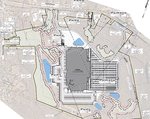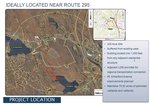

After more than 3½ hours of presentations, questions and public comment, the Johnston Planning Board on Tuesday approved the master plan for a proposed major distribution facility on Hartford Avenue.
The opening 90 minutes of the special meeting focused on Bluewater’s blueprints and potential impact on the surrounding area, featuring testimony from DiPrete Engineering Vice President Nicole Reilly and planning expert Joe Lombardo. The unanimous vote also included separate motions on dimensional variances and waivers requested by Bluewater.
Attorney John Bolton led proceedings, largely uninterrupted by questions initially, during which Bluewater Principal Don Chase explained the layout and design of the facility for more than 100 people in the virtual audience.
None of the “Project Schooner” representatives announced the identity of their client, which has rumored to be Amazon. A couple of speakers during the public comment portion of the evening referred to the building as an Amazon structure, which was neither confirmed nor denied when mentioned.
“We believe Project Schooner is a win for the town of Johnston, a crucial economic development from a rapidly growing industry leader in the landscape,” Chase told the board.
Chase took a three-pronged approach to explaining why the facility would be beneficial for Johnston, including the addition of more than 1,000 full-time jobs and a “responsibly developed” plan that includes relocating an existing solar farm on the site and “preservation and protection of natural resources.”
He said the proposal also represents a more than $300 million investment, relying on locally sourced services and expanding the town’s tax base. Chase said the 200-acre site is about the size of downtown Providence, but Reilly would later testify that only about one-third of the land will be developed. The presentation noted the main building would be located a minimum of 1,000 feet from “any adjacent residential structure,” and about 70½ acres are protected wetlands. He said the center would open in the first half of 2023.
Reilly said there will be two access points off of Hartford Avenue en route to the 820,000-square foot, 120-foot-tall distribution facility. The blueprint for the building shows a massive parking lot to the east, with loading docks in the south and west. She noted the building is less than 10 percent of the total site, while parking composes 20 percent of the footprint and drainage and roadways account for another 11 acres. About 70 acres, or 36 percent, of the site would be developed. Town Planner Thom Deller, in response to a question in the Zoom comment section, said it’s “highly unlikely” the remaining acreage would be developed in the future because of protected wetlands.
“The biggest limitation is the presence of wetlands,” Reilly said. “We’re trying to make sure we’re not impacting wetlands. The proposed parking is as far back into the site as possible for neighbors.”
Reilly said that while the process is in its infancy, “initial due diligence” has been conducted regarding tie-ins to local water and sewer lines near the property. The 14.6-acre solar field on site will be relocated as part of a secondary project.
Lombardo added during his remarks that “this is the type of business envisioned when the town enacted the B-3 zone” for the area.
The public hearing drew mixed reviews of the proposal, starting with concerns from Warwick’s Rob Cote and Western Cranston’s Caren Belli. Cote was worried about dust mitigation from the project and urged the board not to overlook “negative ramifications of every Amazon project in neighboring communities.”
“Why is it the Schooner Project? Everyone knows it is an Amazon distribution center. It’s a bit deceptive we don’t tell residents it is an Amazon distribution center,” Cote said, noting he’s connected to a separate Amazon facility. “There’s a high stress rate, high worker injury rates, workers are basically treated as disposable. Listen to the testimony on the other side of the development of the project. I would hope everyone keeps an open mind and does their due diligence to look at the negative side.”
Belli asked for clarification on what’s in store for undeveloped land in the area, to which Deller said the property would remain “undisturbed.” She echoed Cote’s sentiments about the workplace environment, but added that she would prefer to see the project in a currently vacant lot or brownfield site.
At that point, Planning Board Chairman Josh Laurito interjected to say, “I’d rather hear from Johnston residents in regards to their concerns as opposed to you proposing different land sites for this project.” He requested that non-residents wait until after those who live in the town were done speaking to offer their comments.
The board then heard from a half-dozen Johnston residents, starting with former Dist. 42 state Rep. Stephen Ucci. While he lauded Bolton’s presentation and offered support for the overall plan, he implored the board to “really look at what the impact is going to be on residents.”
“This is a great project for us,” Ucci said. “I’ve seen in my research where they’ve paid over $5 million in property taxes. … We have the time to do it. I’d like to welcome the developer with open arms, I just want to make sure we do what’s right and we minimize the impact to the residents.”
Mike Zannini, a resident who lives within a half-mile of the proposed site, asked Bolton about mitigating the noise level of trucks operating on a 24/7 basis at the facility. Bolton cited Johnston’s “strict” noise ordinance and said he was “quite confident” they will ameliorate those concerns.
Michael Sabitoni, president of the Rhode Island Buildings and Construction Trades Council, said that he has not only lived in town for five decades but represents the workers who may be employed on such a project. He said the facility would be a “win-win.”
“The quality of life will be better for Johnston residents,” Sabitoni said, adding that major construction proposals such as this often have “inconveniences” for surrounding citizens.
Sean Connor of Johnston pushed back against the idea that quality of life will be enhanced, especially for those in the west end of town. He asked Bolton if truck traffic would be going through the west entrance, to which Bolton said that is the plan, but no final decision has been made yet.
Sam and Rhonda Sasa, who own property 50 feet from the proposed entrance of the facility, were worried about the “noise, the dust, the blasting” that such a project would require. Sam Sasa said they are not opposed to the project, but would like to talk further with Bolton and Bluewater.
Comments
No comments on this item Please log in to comment by clicking here